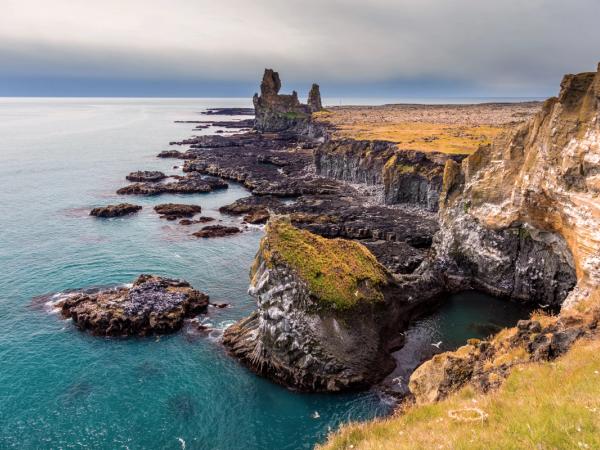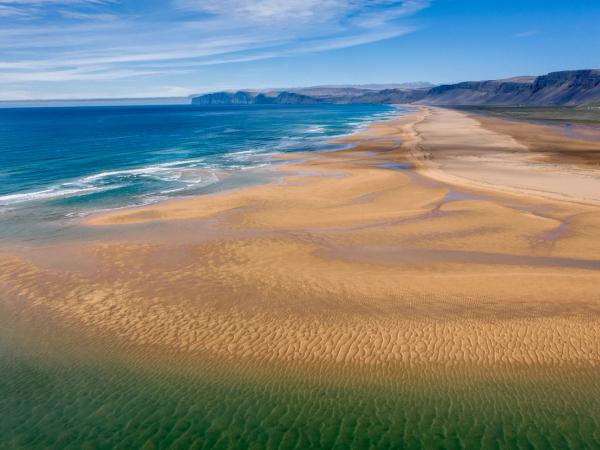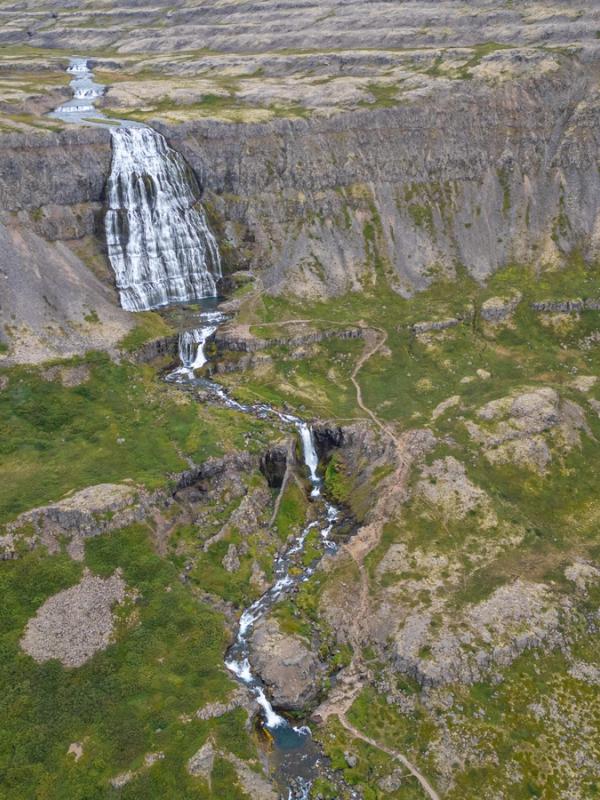
Dynjandi Waterfall: Iceland's Thundering Beauty in the Westfjords
If you're looking for a magnificent waterfall without the crowds, Dynjandi in Iceland's remote Westfjords might be precisely what you’re looking for. This cascade isn't just another waterfall; it's a natural wonder that matches its Icelandic name, which means "thunderous."
Unlike the more accessible waterfalls along Iceland's Ring Road, Dynjandi rewards those who venture into the quieter Westfjords with its seven-tiered structure, calm setting, and incredible views.
What's Dynjandi?
Dynjandi, also called Fjallfoss, is the main attraction of Iceland's Westfjords. This isn't a simple waterfall; it's a series of seven cascades that form a widening shape, starting at about 30 meters at the top and stretching to 60 meters at the base.
The waterfall looks like a wedding veil or giant staircase, with water flowing down roughly 100 meters of rocky steps. Each of the seven falls has its own name: Hæstahjallafoss at the top, followed by Strompgljúfrafoss, Göngumannafoss, Hrísvaðsfoss, Hundafoss, Bæjarfoss, and finally the main Dynjandi fall.
What makes it special, besides its impressive size, is how it spreads out as it falls, creating a fan-like shape unlike other Icelandic waterfalls. Just hearing the sound is worth the trip: a steady, strong rumble that fits its "thunderous" name.

Formation, Geology & Key Features
Dynjandi's unique look comes from Iceland's geology. The waterfall formed over millions of years through volcanic activity and erosion.
The Westfjords sit on some of Iceland's oldest rock formations, dating back 10-15 million years. Dynjandi shows layers of basalt (hardened lava) mixed with softer sedimentary rocks. As water flows over these layers, the harder basalt stays firm while the softer layers erode faster, creating the step-like tiers that give Dynjandi its character.
The water comes from the Dynjandisá river, which starts in the Highlands and glaciers of the Westfjords. The flow changes with the seasons: in summer, melting snow and rain can increase it up to 8 cubic meters per second, while winter sees it slow to about 1 cubic meter per second.
If you look at the falls closely, you'll see the rock faces behind the water. These exposed layers show Iceland's volcanic history, with clear horizontal lines marking different eruption periods.

Location & How to Get to Dynjandi
Dynjandi sits in the Arnarfjörður fjord in Iceland's Westfjords region, away from the usual tourist paths. The waterfall is about 360 km (224 miles) from Reykjavík, making it a true adventure to reach.
The main route is via Vestfjarðavegur (Road 60), which curves through the Westfjords' landscape. You have two main ways to get there:
From Reykjavík:
- Distance: 363 km (226 miles)
- Driving time: About 5 hours
- Route: Take the Ring Road (Route 1) north from Reykjavík, then connect to Route 60 at Búðardalur. Follow Route 60 through the Westfjords until you reach the turnoff for Dynjandi.
From Ísafjörður (the largest town in the Westfjords):
- Distance: 80 km (50 miles)
- Driving time: About 1.5 hours
- Route: Head south on Route 60 from Ísafjörður, crossing the Dynjandisheiði mountain pass.
You'll know you're getting close when you see signs for Dynjandi or turn onto Road 621. The final approach is a short gravel road leading to a parking lot at the base of the falls. From there, it's time to start walking.
Parking at Dynjandi costs 750 ISK, which you’ll have to pay via the Glaze app.
The Hike to Dynjandi
From the parking lot, a marked trail leads to the base of the main waterfall. The hike takes about 15 minutes and involves climbing about 200 meters in elevation.
The trail, built by volunteers in 1996, is rocky but doable for most fitness levels. It passes the six smaller waterfalls, giving you plenty of photo spots along the way. There are wooden steps in some sections and gravel paths in others.
The path can get slippery, especially when wet from the waterfall's spray, so wear shoes with a good grip. The effort is worth it; each step brings you closer to the main cascade, with the sound growing louder as you approach.
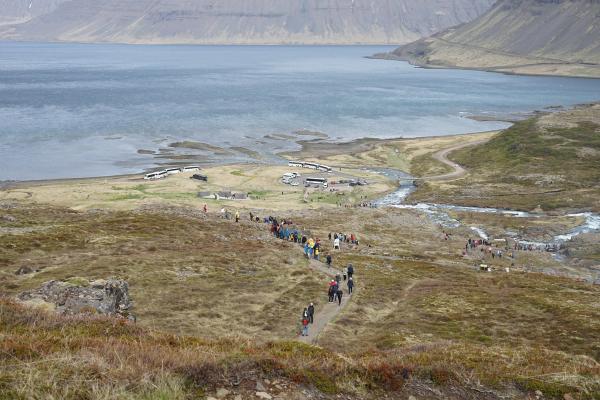
Things to Do at Dynjandi & Around
Dynjandi offers more than just a quick photo stop. Here's what you can do at the waterfall and nearby:
1. Photography
Dynjandi is perfect for photography, with its unique shape and setting. For the best shots, visit in the early morning or evening when the soft light creates nice effects on the water. A wide-angle lens helps capture the full waterfall, while long exposures create a smooth, silky water effect. Bring a tripod for those long exposure shots. The waterfall looks different from various angles, so walk around to find different views.
The mist near the falls will likely get your camera wet, so bring protection. A simple rain cover or plastic bag would do the trick.
2. Hiking
Beyond the main trail to the waterfall, the area has other walking options to explore this landscape further. Take time to see each of the smaller falls along the main path; each one has its own character. For those feeling more adventurous, unofficial trails around the base let you explore the area more deeply, though be careful as the ground can be slippery.
The views of Arnarfjörður fjord from higher points are impressive and worth the extra climb. In summer, notice the local plants that grow here; various mosses cover the rocks, while ferns and wildflowers add color to the volcanic landscape.
3. Birdwatching
The Westfjords are home to many birds, especially during summer. The cliffs near Dynjandi make perfect nesting spots for seabirds. Look for puffins with their colorful beaks nesting in nearby cliffs. They're usually there from May to August. Arctic terns fly overhead, known for their distinct calls and graceful flight. Along the fjord, you might see kittiwakes and guillemots, while ravens often fly above the falls, riding the air currents. If you like birdwatching, bring binoculars to observe many species from a distance without disturbing them.
4. Picnicking
The parking area has picnic tables where you can eat with a view. The water from the falls is clean and drinkable, so bring a bottle to fill up.
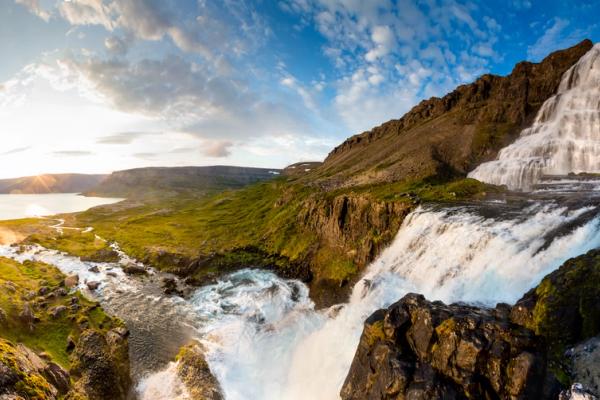
5. Nearby Attractions
Make the most of your trip to this remote region by visiting these nearby places:
- Látrabjarg Cliffs (124 km, 2 hours by car): Europe's largest bird cliffs, home to millions of seabirds, including puffins, in summer.
- Rauðisandur Beach (100 km, 1.5 hours by car): A beautiful red sand beach that stands out against the blue sea.
- Ísafjörður (80 km, 1.5 hours by car): The largest town in the Westfjords, with museums, restaurants, and places to stay.
- Hrafnseyri Museum (5 km, 10 minutes by car): A small museum about Jón Sigurðsson, a leader in Iceland's independence movement.
Best Time to Visit
The time of the year you choose to visit Dynjandi can make a big difference in what you experience.
Summer (June-August)
Summer works best for most travelers. The weather is milder with temperatures between 10-15°C (50-60°F), making hiking comfortable. You'll have almost 24 hours of daylight thanks to the Midnight Sun, giving you plenty of time to explore and photograph the falls in different light. This is when the waterfall has its strongest flow, creating the most impressive display as water falls down the tiers.
All roads to Dynjandi are open during summer, so you won't worry about road closures. Summer is also when wildlife is most active, so you'll have the best chance of seeing birds and other animals nearby.
Spring (April-May)
Spring offers a different experience with fewer visitors, creating a quieter atmosphere. The increasing flow from melting snow means the waterfall begins to show more power after winter. This is when migratory birds start returning to the area, making it good for birdwatching. However, weather and road conditions can change quickly, so check forecasts and road status before setting out.
Fall (September-October)
Fall brings autumn colors to the landscape around Dynjandi. Tourist numbers drop significantly, giving you more quiet time with the waterfall. The darker nights increase your chances of seeing the Northern Lights above the falls if the skies are clear. Prepare for cooler temperatures and shorter days, which limit the time available for exploring.
Winter (November-March)
Winter shows Dynjandi in a completely different way. The waterfall may be partly frozen, creating a mix of ice and flowing water. This season offers the best chances to see the Northern Lights, with dark skies and minimal light pollution. You'll have extreme quiet, as few travelers visit the Westfjords in winter.
However, limited daylight hours (as little as 4-6 hours in December/January) restrict the sightseeing time. Road access becomes difficult or impossible without special vehicles, and the water flow reduces to about a quarter of the summer volume.
Remember that even in summer, the Westfjords can be cold and windy, so dress in layers.

What to Wear When Visiting
Iceland's weather changes quickly, especially in the Westfjords. Here's what to pack for your Dynjandi trip:
- Waterproof hiking shoes with good grip – the trail can be slippery
- Waterproof jacket – you'll get wet from the mist near the falls
- Layers – even in summer, temperatures can range from cool to cold
- Hat and gloves – especially in spring, fall, and winter
- Sunglasses – helpful on bright days and for protection from the mist
- Bug netting – midges can be annoying in summer
- Quick-dry clothes – you'll likely get at least a little wet
Remember the Icelandic saying: "If you don't like the weather, wait five minutes." Be ready for sun, rain, and wind all in the same day.
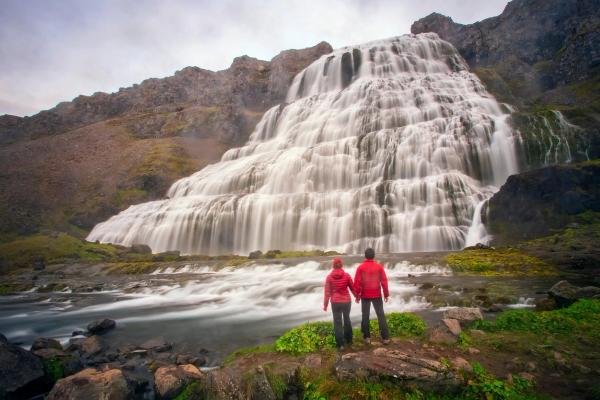
Best Campsites in the Area
While camping directly at Dynjandi isn't allowed, there are several good options nearby:
Tjaldsvæðið Flókalundi (Flókalundur Campsite)
- Distance from Dynjandi: 30 km (18.6 miles), 30-minute drive south
- Facilities: Tent and campervan sites, toilets, showers, drinking water
- Highlights: Access to Hotel Flókalundur's restaurant and shop, nearby hot springs
- Open: May-August
Þingeyraroddi Camping Ground
- Distance from Dynjandi: 28.5 km (18 miles), 28-minute drive north
- Facilities: Toilets, showers, electricity, kitchen, laundry
- Highlights: Located in Þingeyri village with views of Dýrafjörður fjord
- Open: All year round
Tungudalur Campsite (Ísafjörður)
- Distance from Dynjandi: 53 km (33 miles), 44-minute drive north
- Facilities: Modern amenities including kitchen, dining area, Wi-Fi
- Highlights: Close to Ísafjörður's services and attractions
- Open: May-September
If camping isn't for you, consider staying in Ísafjörður, which has hotels and guesthouses, or the simpler accommodations at Flókalundur.
Why is Dynjandi Worth Visiting
In a country known for its waterfalls, Dynjandi stands out for several reasons:
Unique Shape and Structure
Its shape is unlike any other waterfall in Iceland, with its widening, cascading tiers creating that bridal veil appearance. The way it fans out from top to bottom creates a visual that's easy to recognize and completely different from the straight drops of many other famous falls.
Peaceful Experience
The quiet you'll find here contrasts with the crowds in southern Iceland, letting you connect more deeply with nature. While popular spots along the Ring Road might have you competing for a space to take a photo, at Dynjandi you can often find moments of quiet, even in summer.
Breathtaking Setting
The setting adds to its appeal, with the waterfall framed by mountains and fjords in all directions. The backdrop of Arnarfjörður fjord creates a striking contrast between the falling water and the rough landscape, especially on clear days when the water shines against the dark basalt.
Journey of Discovery
Getting to Dynjandi is part of the adventure, taking you through Iceland's most remote and possibly most beautiful region. The drive along winding coastal roads and mountain passes is an experience in itself, with new views appearing around every turn.
Multi-Faceted Experience
The multiple tiers offer different views and experiences as you climb, letting you appreciate the waterfall from various angles. Each of the seven cascades has its own character, creating a journey of discovery as you make your way up the trail.
Pristine Natural Monument
This area shows untouched nature at its best and has been a natural monument since 1981, keeping its pristine condition. The protection status has helped maintain the waterfall's natural beauty and the surrounding ecosystem.
Photographer's Paradise
For photographers, the mix of light, mist, and the waterfall's unique shape creates many opportunities for stunning images. The way the light hits the water changes throughout the day, offering different moods to capture.
Gateway to the Westfjords
Dynjandi also serves as a good starting point for exploring other treasures of the Westfjords region, from bird cliffs to red sand beaches. Its central location makes it a perfect anchor point for a broader exploration of this often-overlooked part of Iceland.
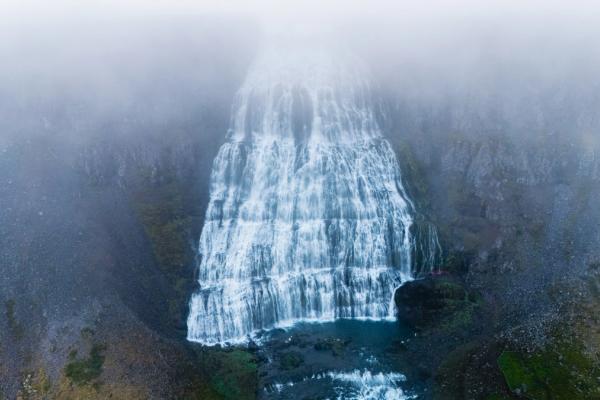
Summary
Dynjandi is a highlight of Iceland's Westfjords, rewarding travelers with its unique cascading beauty and powerful presence. The waterfall's distinctive shape, seven-tiered structure, and relative quiet make it worth the journey.
If you want to escape the tour buses and experience Iceland's raw power and beauty, put Dynjandi at the top of your list. This thunderous cascade might be the highlight of your Icelandic journey.


